Semi-trailers are widely used across the world to transport goods. Manufacturers use semi-trailers to carry raw materials and finished products.
If you have just started the transport business or looking for a trailer, you need to learn everything about semi-trailers. Without proper information, you may invest your money in the wrong transporter.
You also need to learn how to use and maintain semi-trailers.
In this book, you will learn the basic application of the transporters in the past and present. You will also learn the features and structures of semi-trailers.
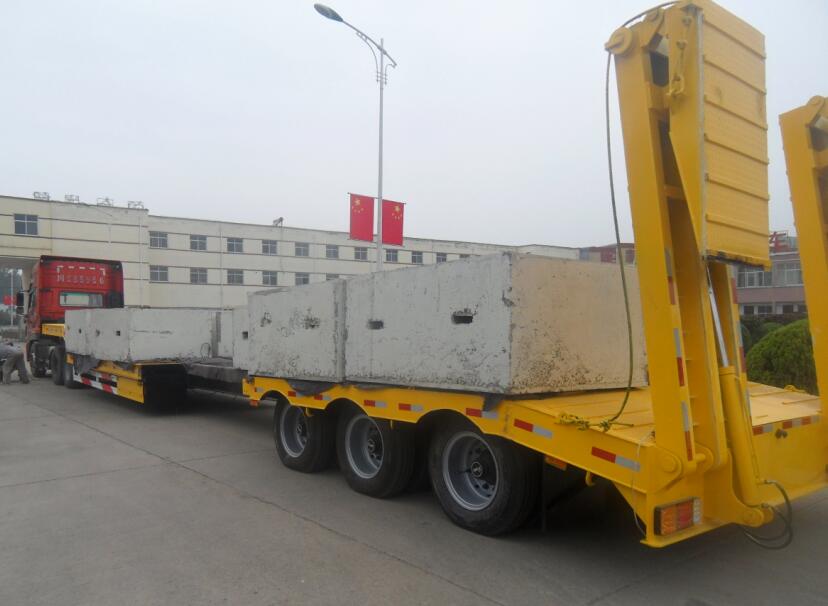
Load test
Semi-trailers are very important to the US economy. Households and firms depend on them to get their products on time. Companies depend on them to distribute their products to customers in good condition.
This guidebook discusses this further and shows you the contribution of semi-trailers to the US economy. The guidebook also shows you some of the things you need to be aware of when maintaining semi-truck trailers.
Luckily, you have a new complete guidebook with everything you need to know about low bed trailers now. (download free)
Low Bed Trailer Ultimate Guide
-
Basic information you should know about semi-trailers
A semi-trailer is defined as a freight trailer without a front axle. A road tractor or a dolly supports the weight of the trailer. The trailer has dozens of wheels that are lowered to support it when it is detached from the tractor.
Alexander Winton invented the first semi-truck in 1898 in Cleveland Ohio. He sold the first semi-truck the following year. Alexander had started manufacturing horseless carriages or cars in 1896.
However, he had no way of transporting the cars to customers who lived far from Cleveland. Alexander could not drive the cars to the customers because of wear and tear.
Such a delivery was also expensive. The concept of semi-truck was invented from this need. The first semi-truck for transporting vehicles was manufactured in 1899. He also manufactured semi-trucks for other car manufacturers as well.

The first semi trailer was made of a modified automobile and an attached cart. It had an engine at the back below the platform.
It could only transport one vehicle at a time. One blacksmith in Detroit, August Charles Fruehauf, introduced a better design in 1914. He built a hauler for someone to transport his boat.
He attached the carriage to a Ford, which made it very popular. It was the first hauler to be officially called a semi-trailer. August formed the Fruehauf Trailer Company that is among the leading semi-trailer manufacturers.
After this invention, improved designs were introduced. John Enderbrock introduced his trailmobile that had an iron chassis supported by wheels. It had springs to attach the trailer to a Ford or any car.
The transport business moved to another level in the 1920s when George Cassens introduced new car haulers.
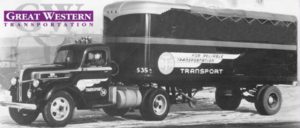
Mack Trucks introduced heavy-duty commercial vehicles between 1929 and 1944. The vehicles gained popularity because of their resilience and durability.
The development of the logging industry caused a major shift in the manufacture of semi-trailers. New semi-trucks with a higher capacity were required to transport logs from the forest to the mills.
Before trucks were introduced, millers used horse or rivers to move logs. Semi-trailers have evolved from the first invention that could only haul one car to the modern 18-wheelers.
Modern tractors have three axles. The front axles steer the tractor or truck while the rear axles steer the trailer. The rear axles provide power to the front tractor.
- Reasons why semi-trailers are used widely in the transportation industry
Semi-trailers are very important to the US economy. Most of the companies depend on them to transport raw materials and final products.
Semi-trailers handle more goods than trains, ships, and aircrafts. In the United States, it is estimated that semi-trailers transport goods worth $700.4 billion.
The weight of these goods is estimated at over 10 billion tons. In addition to transporting raw materials and finished goods, semi-trailers are a source of employment.
More than 800,000 drivers in the US transport goods with semi-trailers. The drivers earn about $30 billion dollars every year. The drivers spend their earnings in the US economy, which helps in expanding firms.
Truck drivers earn an average of $28,000 in their first years. The pay can increase to up to $68,000.
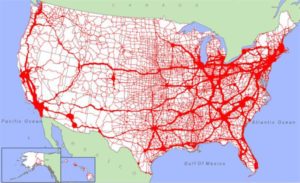
If the semi-trailer business were to close down, most of the industries in the US would suffer. Some of the industries that depend on semi-trailers include waste removal, healthcare, and retail.
Others include food, transportation, and manufacturing. These industries cannot run without an efficient means of transporting goods in bulk.
The trucking business requires support from the government to keep running. The rules and regulations should enable carriers to transport as many products as they can efficiently.
In addition, carriers have a role to play in creating good working conditions for truck drivers. Most of them quit after a few months because of the busy work schedule.
Given their contribution to the US, they deserve better pay and flexible working schedules that gives them enough time to rest.
- Features and structures of semi-trailers
A semi-trailer has many parts and each part contributes to its function. The largest part is the frame that holds many other parts.
The frame holds several beams including the main beam, supporting beams, side beams and connecting beams. The frame also holds traction pins and panels.
Supporting beams are often made of strong steel because they require
enough strength.
Side beams are usually made of bent parts of channel steel. The upper part of the trailers holds the goods in transit. It has a sidewall and portal frame.
There are two types of sidewalls that include a vertical corrugated board and a flat plate. The vertical board is mostly used to increase the strength of the trailer.
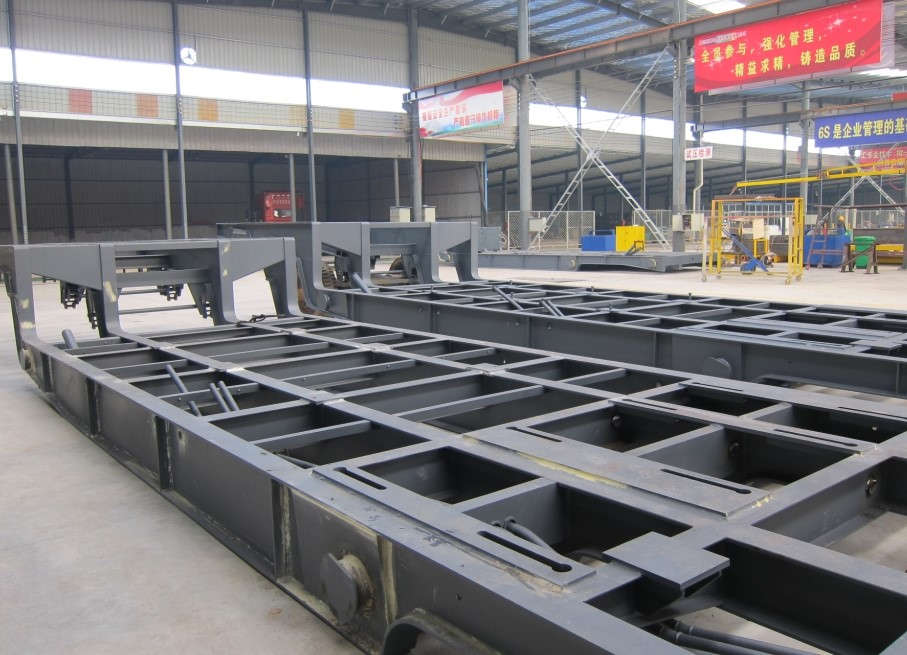
The portal frame is also called a front board and it can be removed depending on the type of cargo. The front board is mostly used when transporting very heavy goods.
Other important components of the trailer are kingpins. A kingpin is used to connect the trailer to the truck or tractor. Most kingpins are made of chromium alloy steel.
How do the parts of the trailers move, you may ask. Semi-trailers have their braking system that keeps the wheels stationary until the truck is ready to move. The electric system consists of parts for lighting, gas supply, and security alerts.
The electric system also has lamps, cables, and seven core receptors. A semi-trailer has a support device that supports the trailer when it is detached from the tractor.
The trailer has a side and rear guard that warns other road users to keep a distance from the trailer. Other important components include the suspension, axles, and tires.
These parts control the steering or the movement of the trailer. Manufacturers make semi-trailers with different structures depending on their usage. The structures of different types of trailers are discussed below:
- Low bed and RGN trailers
The two types of trailers are designed to transport the tallest and heaviest freight. However, the structure and capacities of low-bed trailers and removable gooseneck (RGN) trailers are different.
Low-bed trailers mostly have two axle lines and can carry up to 80,000 pounds with additional axle lines. RGN trailers on the other hand can carry up to 150,000 pounds of freight.
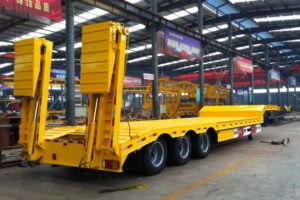
Most RGN trailers the 3 axles, which enables them to carry heavier loads than low bed trailer. The main difference between the two trailers is the trailer for an RGN trailer can be detached.
The trailer is lowered to rest on its ramp. Hence, motorized equipment and other cargo with wheels are driven on to the trailer. You will find RGN trailers carrying heavy motorized items because of this feature.
When the goods are loaded, the trailer is lifted and reattached to the truck. Low-bed trailers cannot be detached. They require lifting equipment to load the heavy products.
- LNG, LPG, and CNG tanker trailers
Some semi-trailers designed to transport gas and other petroleum products. Gas tanker carriers have different structures depending on the type of gas they transport.
LNG required high insulation and low temperatures to be transported in liquid form. The gas is transport at its boiling point, which is -162℃. LNG carriers have membrane tanks with high vacuum multilayer insulation.
The layers of membrane tanks include the primary barrier or metal layer, the insulation layer, a liquid-proof layer, and a second insulation layer. LNG is also transported in spherical tanks or self-supporting tanks that most people think of as LNG carriers.
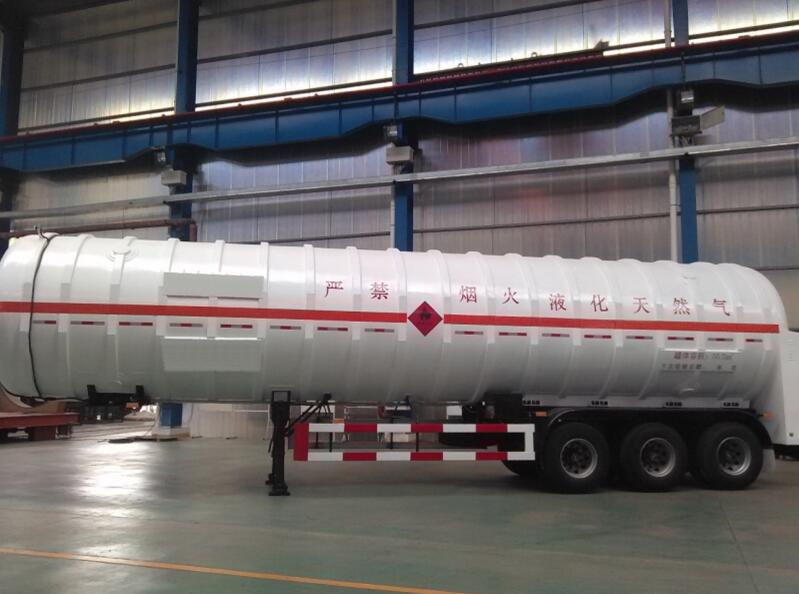
Some semi-trailers designed to transport gas and other petroleum products. Gas tanker carriers have different structures depending on the type of gas they transport. Liquefied Petroleum Gas (LPG) is heavier than LNG.
It can be liquefied through refrigeration or by applying high pressure. Its major components are butane and propane. It remains heavy even when it is heated. LPG can evaporate when heated.
Hence, it is transported under high pressure to keep it in liquid. LPG containers include T14, T20, T50, T23, etc.
CNG tank trailer is a new professional storage and transportation equipment for Compressed Natural Gas (CNG), the features are flexible, convenient, efficient.
Here is a new complete guidebook of tank trailer. (download free)
Tank Trailer Guide Book – Learn All about Tanker Trailers
It is the latest means of mass transportation specialized for compressed natural gas, applies to road transport compressed natural gas (CNG) (does not apply to the transportation of liquefied gases and dissolved gases).
- Car carrier trailers
By now, you know that the first semi-trailer was built to transport cars. Semi-trailer manufacturers still design heavy haulers for car transportation.
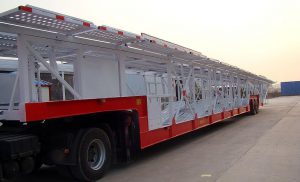
A car carrier trailer has a long platform. Some have stacking platforms such that they can carry several cars at the same times.
Standard car carrier trailers can transport seven or eight cars depending on the combinations of cars. A trailer will carry more cars if most or all of them are small cars.
Car haulers have large and tough wheels that can handle the pressure from several cars. Sometimes the trailers transport heavy trucks and hence the need for sturdy wheels.
- Container trailers
Container chassis are designed to carry heavy loads. Containers have different dimensions but their structure is in most cases the same. The length of containers ranges from 20 feet to 40 feet.
Container trailers can carry combined dimensions of containers to maximize the space of the platform. For heavy haulers, containers are sometimes stacked together.

The main consideration when transporting containers is the legal freight height. While it is possible to stack many containers together, the freight weight must remain within the legal freight.
Otherwise, carriers have to pay a penalty or fee when they break state regulations. Some container trailers come with side loader to make it easier to load containers. The side loaders slide containers of different dimensions onto the trailers without bending the containers.
- Dump semi-trailers
Dump semi-trailers are also referred to as tipper trailers. You must have come across these trailers no matter where you live. The tipper trailers are normally used to carry loose construction materials.
Some of the items the trailers carry include ballast, sand, and gravel. The trailers are also used to carry demolition waste from construction sites. The unique feature about these trailers is that they have a hydraulic piston or hoist.
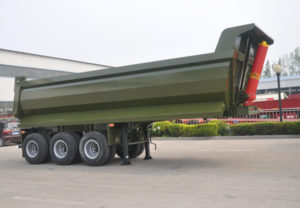
The piston lifts the trailer at the front so that the materials are dumped on the ground. For this reason, they are called dump trailers.
Dump semi-trailers can have 2 or 3 axles depending on the level of construction. For instance, road construction requires materials in large amounts. Hence, 3-axle tippers are used for such construction projects.
- Van Trailers
Van trailers are also very common because they transport all types of products. The trailers consist of a rectangular box with wheels. The box is attached to a truck.
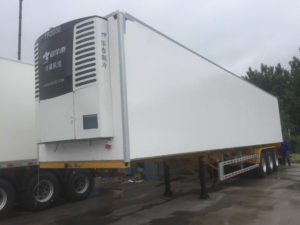
The inside of the box is designed based on the type of goods it will transport. The most common types are dry van trailers and refrigerated van trailers.
As the names suggest, dry van trailers all types of goods while refrigerated van trailers carry refrigerated products. The later are widely used to carry food products. Unlike many other trailers, van trailers are often light but strong.
- What you need to notice when maintaining semi-trailers
The information in this guidebook will help to pick the right trailers for your business. However, the durability of the trailer will depend on your approach when maintaining the truck.
It is important to note that every part of the semi trailer requires attention. Hence, your mechanic should check all the parts occasionally. However, there some parts that you must check regularly to keep the trailer running.
Tires: One of the most important inspections of your semi-trailers is the tires. Semi-trailers carry heavy loads. It is easy for the tires to lose their pressure often.
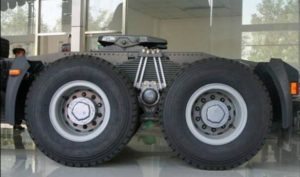
Every brand of tires has the optimal tire pressure. Maintain your tires at that pressure. Make it a habit to check the pressure along the way when taking a long trip.
Otherwise, you will incur a high expense of replacing tires often. Another way of ensuring that the tires maintain their pressure is to avoid exceeding the maximum load capacity.
Ensure that the load weight does not exceed the recommended capacity for the trailer. Check the wheel alignment and wear and tear. Check for any indents on the tires.
If the tires are worn out, you need to replace it immediately.
Axle alignment: It is important to check the axle alignment for proper steering. If the axles are not properly aligned, the outer wheels may not touch the ground.
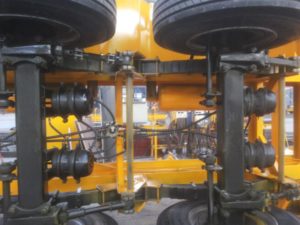
Hence, the semi-trailer will exert excess pressure on the inner wheels. You need to inspect the alignment of all axles regularly and correct any misalignment immediately.
Frame: Check the body and supporting beams for excessive rust. A little rust on the surface is normal but excessive rust requires attention. Consider repainting the trailers and other painted parts if you notice excess rust.
Air-spring suspensions: Loose fasteners like bolts can cause a semi-trailer to roll over when carrying heavy loads. Confirm that all fasteners are tightened especially before loading heavy cargo.
Do not ignore one loose bolt or fastener even if the other bolts appear 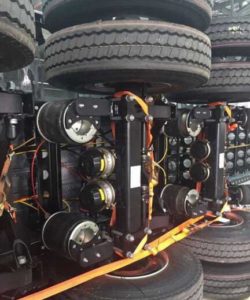 tight. Loose bolts cause excess wear and tear on the rubber.
tight. Loose bolts cause excess wear and tear on the rubber.
You may need to replace the rubber later if you ignore the loose bolts.
Braking system: Trailer brakes should be inspected often. Always check the drum conditions when adjusting the brakes.
Check for any wear and tear on the brakes and speed of releasing air when moving the trailers.
Lighting and electrical system: Sometimes corrosion causes the lighting and electrical system to stop working.
Inspect the trailer for any corrosion and correct it before it affect the electric system. Check the wires for wear and tear.
You need the rear lamps working when driving a trailer at night. The lighting system keeps you and other road users safe.
The inside parts: Sometimes drivers inspect all the exterior parts of a trailer and forget the inside. Check the walls and floor for corrosion.
The easiest way to prevent corrosion on the inside is to keep the trailer clean. Clean it after transporting every type of cargo. Spillage on the floor may lead to corrosion.
- Conclusion
If you are looking a semi-trailer to buy for your business, this guidebook has all the information you need. You have full information of all the major parts, structures, and different types of trailers.
The information will also benefit you if you are a truck driver. In fact, every truck driver need to learn how semi-trailers function.
You can solve minor mechanical issues when driving a semi-trailer if you know how it works. The guidebook also shows how semi-trailers have evolved since their inventions.
The first semi-trailer had an engine under its platform. It could only transport one car at a time. Today, we have 18-wheelers that can carry tons of loads.
Semi-trailers drive the US economy by providing jobs to close a million truck drivers. Billions of tons of goods are transported using semi-trailers.
If the semi-trailers were to close down, many industries would also close down. Hence, there is need for carriers to have the right information about the transporters and their maintenance. The information is available in this guidebook.


Great article loved it!